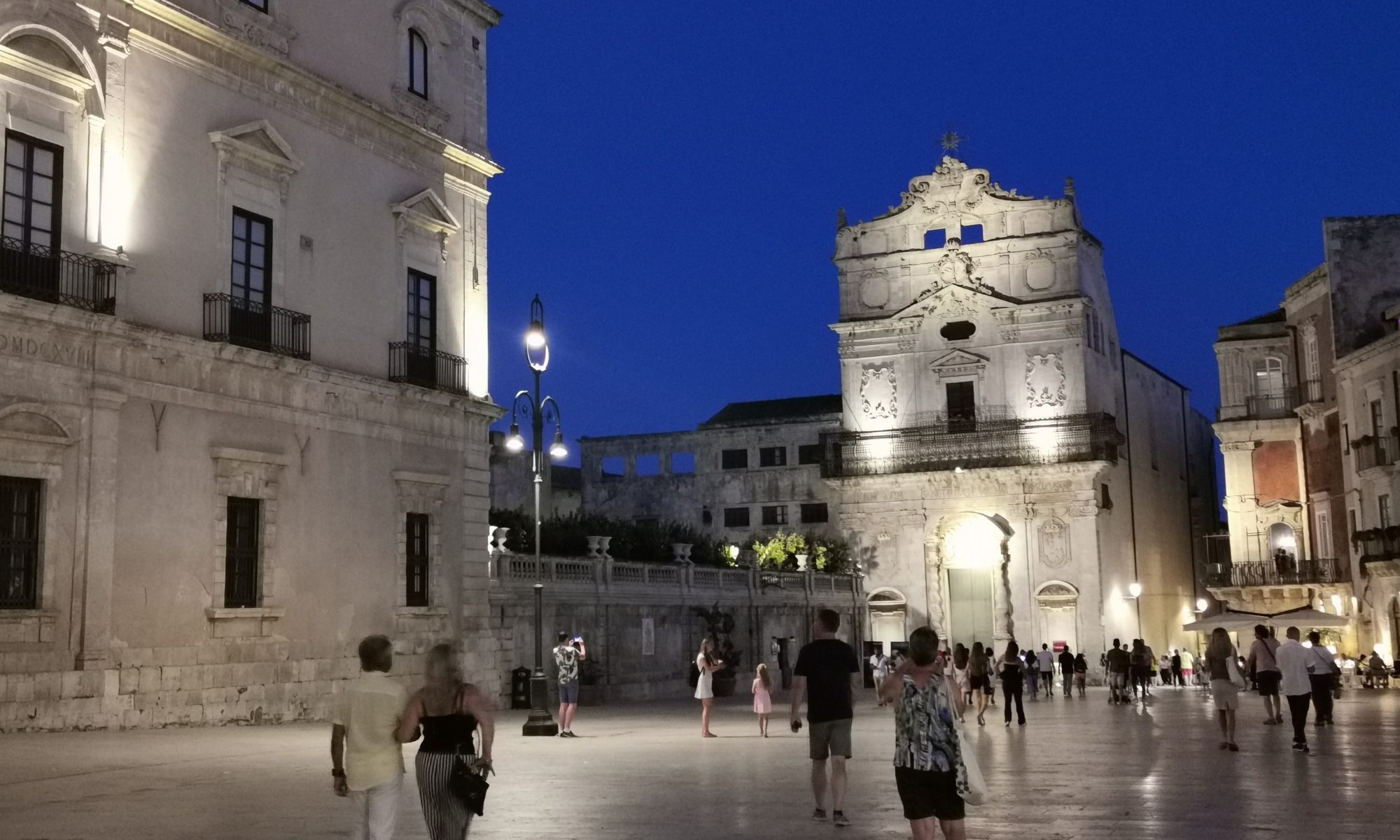When I was a teenager I pinned a quote on my wardrobe which read in laboured calligraphy ‘All Roads Lead to Rome’. It stayed there for years and became a bit of a mantra. I’m not sure where I thought I was heading, but it was a pithy line to throw at foolish decisions.
I finally made it to Rome in late Spring of 2005. I’d always envisaged that entering the Eternal City would be glamorous. I’d arrive pristine in an ivory suit, channelling Sophia Loren alongside a swarthy Latino in an open topped Alfa Romeo Spider. The reality turned out to be dispiriting, involving an overcrowded train from Bologna which hurtled through every one of the seven hills whilst my friend and I stood up in a packed smoker’s carriage and took it in turns to breathe. We arrived at the bewildering Termini, travel sick and eyes streaming, alert for the marauding bag-snatchers we’d been warned about. Things improved rapidly when we saw the soaring majesty of the architecture. Rome is a film set on every corner.
As we begin this travel odyssey together, let me state for the record, I hate Christmas in the UK. I loathe enforced jollity and mawkish television so I opt to get on a plane. This has now become a tradition and alongside my mother – we’ll call her Mamma Flâneuse – we find a different city to experience. It’s taken me a while to win her round to this one. I have a cousin who was once mugged on The Spanish Steps and this has put her off, but Budapest last year has emboldened tastes so here we are, in the heart of the Vatican, with twinkling Christmas lights strung like jewels along the streets and calendars of priest hunks in the shops. After dark, the nuns are out in force, administering food and kindness to the many homeless who shelter under the buttresses around Piazza San Pietro. The billboard of the local cinema towers above our heads with the ironic words I Due Papi. Where else could we be?
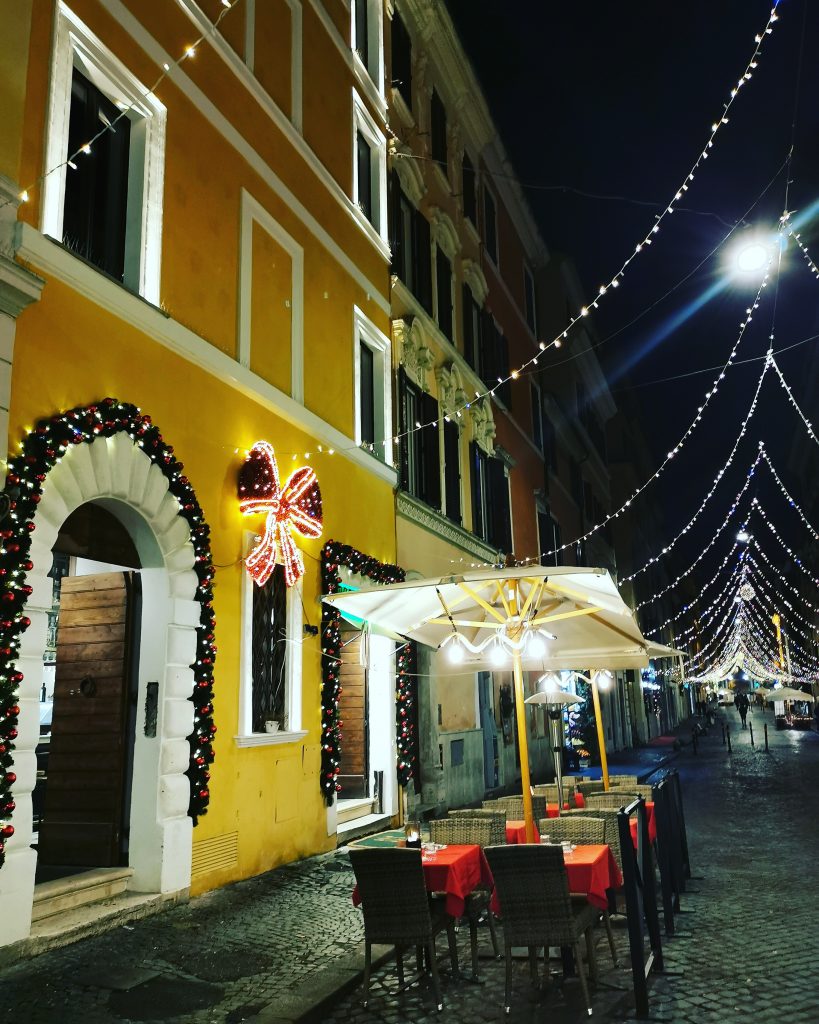
There is an abundance to see in Rome and it’s best not to try and do it all. You’ll fail spectacularly. I never made it to Villa Borghese or the many palazzos and churches that are strewn across it, but that can be for another time. This trip is about Christmas and avoiding the turkey and stuffing.
The dinner on Christmas Eve is the main celebratory meal and it’s always heavy with fish. Our restaurant is not far from Campo de Fiori and we’re going to be sampling sea urchin pasta. It’s hard to describe the flavour and smell of sea urchin, but when I put it in my mouth I know I will still be tasting it next Christmas. Imagine a heady combination of kitchen cleaner and tropical fish food and you are in the ball park. Two Japanese tourists valiantly plough through their plates and I almost expect the late, great Clive James to appear with commentary. The remaining four courses are delicious so I can only conclude it is the ingredients and not the cooking. In the morning, Mamma Flâneuse flings the shutters of our room open and says the place smells of urchin. Merry Christmas one and all!
**********
Christmas morning and Piazza San Pietro is showing us its shiniest face. On the way, we are verbally accosted by six people in the space of 1 minute trying to flog us tickets to the Sistine Chapel. ‘Jesus wept’ says Mamma F.
The sky is like a china blue plate and I have to put a scarf on my head to keep the sun from burning me. We’re here for the Pope’s blessing and so are several hundred thousand other people, only we’re early and we’re getting a seat which has pleased mother and her blister. I have done the Pope thing before. In 2005, shortly after the ordination of the creepy Benedict XVI, we came to the Square to watch him pop up at one of the smaller balconies. There were no barriers or airport style security and the atmosphere was raucous with cries of Papa and people letting rip. It’s more sedate and sanitised today, although we think that some way back the crowd are singing La Bamba with gusto. Turns out they’re actually singing ‘Buon Natale’ to the same tune. It all feels a bit Hare Krishna.
The pomp in the lead up to the Pope’s arrival is magnificent and the biggest crowd pleasers are the harlequin garbed Swiss Guard who get an enthusiastic round of cheers and applause. In order to become the Pope’s personal body guards you have to be Swiss Catholic, male, unmarried, aged between 19 and 30 and have completed basic Swiss Army training. You also have to be prepared to wear tights in the heat. It’s quite a niche role.
As we wait for the clock to strike midday, the silent expectation is extraordinary. You don’t have to practice any kind of religion to find this profoundly moving because it’s about collective faith and hope and it’s the best of us. The Pope, when he arrives, looks like he has the weight of the world on his shoulders. After his address in Italian and the Latin benediction he finally breaks into a smile and you are relieved to see he is happy. The whole morning feels like it has been wrapped up in a bow and given to you as a gift.
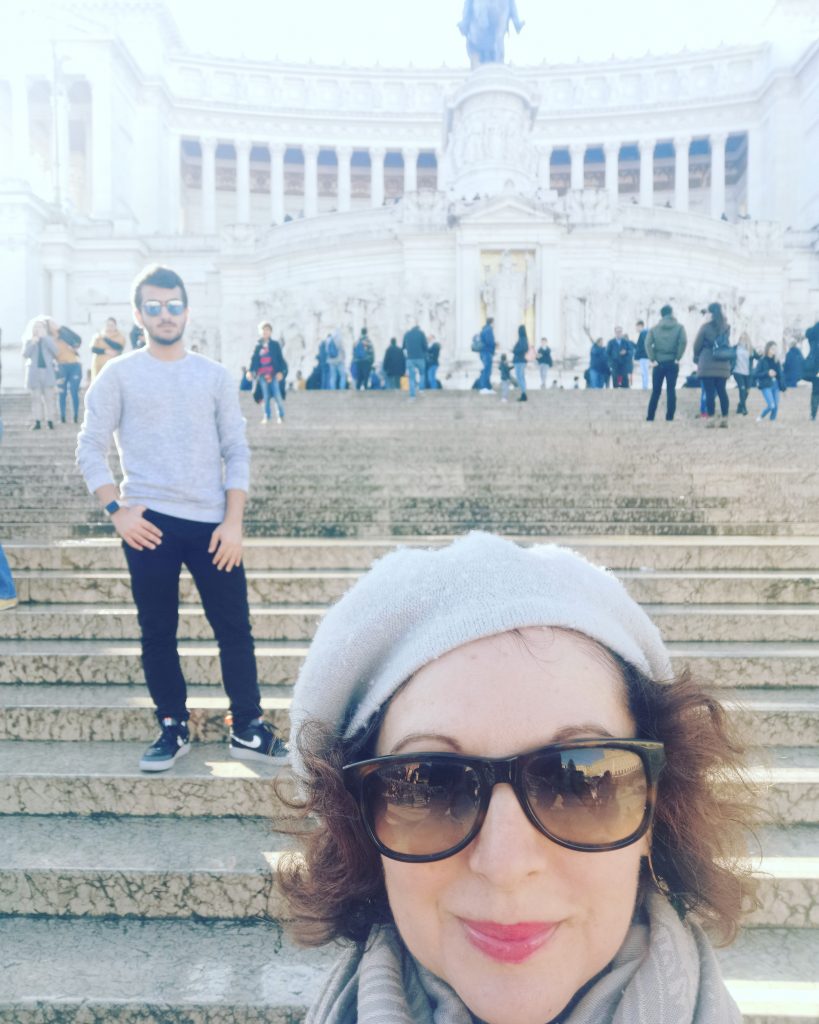
If you are ever in Rome on Christmas Day my best tip is after you’ve seen the Pope, head straight for the Basilica. If you time it right, you can be inside in under 5 minutes and get a privileged view of the crowds slowly dispersing. In the splendour stakes, St Peter outdoes every Catholic Church on earth but for my money, and just for sheer laugh-out-loud audacity, it’s got to be the Vittorio Emanuele II monument. Dedicated to the first king of the unified Italy, the Romans famously hate it. It’s been likened to a giant wedding cake, but I love it’s big dick energy. It says ‘hey, we may be a declining nation, but we’ve still got a massive schlong, a couple of eternal flames and a 717,000 square metres of marble’. One ruminates on what might the London equivalent will be in the coming years. Go and see it, clamber over its many stairs and if you can find the lift (I couldn’t) take it to the very top for an Emperor’s view
**********
So it seems even my café decisions are political. I leave Mamma Flâneuse at the hotel happily watching Lionel Ritchie in concert at the Vatican, and head off along the Tiber. If there’s a river running next to me I can’t get too lost. At the Piazza del Popolo I opt for the Café Rosati as a base to watch the early passeggiata. It’s a random choice but I later discover it was once frequented by left wing writers whilst Café Canova across the square was solely the domain of the right. I order an atomically strong Aperol spritz and am served an exquisite home-made salmon roe pastry. It looks like a small crown of orange jewels and the delicate bubbles burst in my mouth. This blows sea urchin right out of the water.
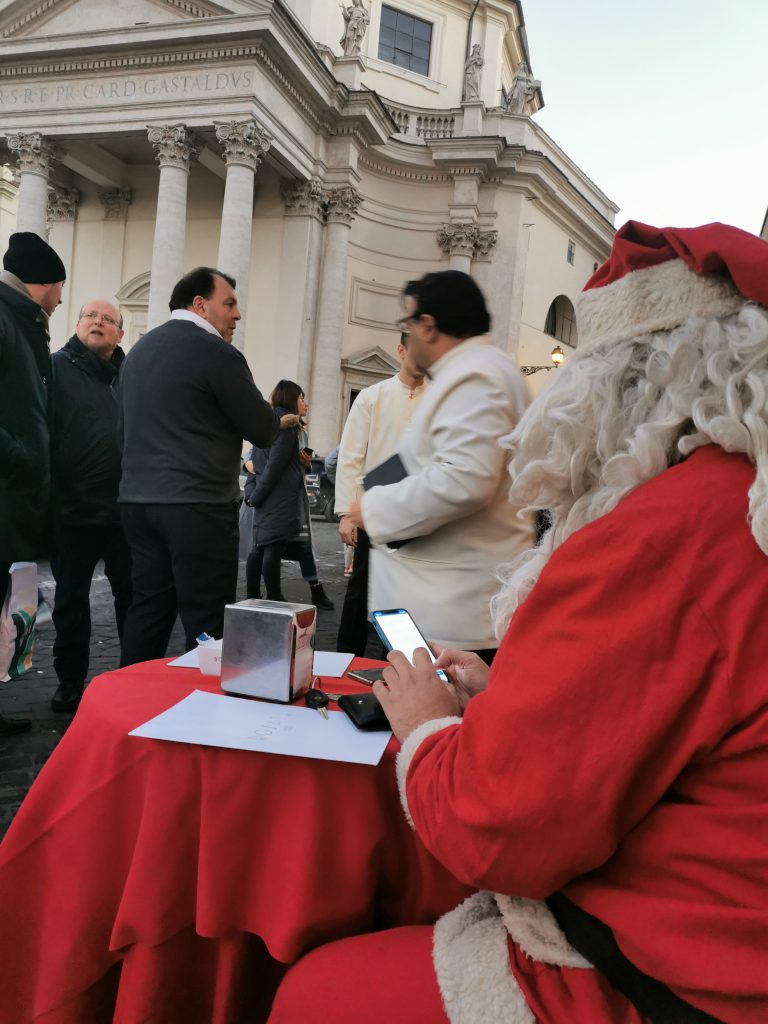
It’s Christmas Day but you get the sense that some people are doing business. A couple of the clientele look like Pauly from Goodfellas (they don’t move fast because they don’t have to) and the crowd is largely well-heeled. A man in a full Santa costume sits down to my right and says salve before checking his WhatsApp messages. His girlfriend is glamorous and dripping in furs and Fendi. You wonder about their sex life.
Although it’s a sprawling city, Rome is not that diverse. Santa aside, for the hour I spend at the Café Rosati, I see more variety in the traffic than in the passers-by. A man on a bicycle festooned with coloured lights; a tiny car packed with people, a silver haired woman giving strong direction from the passenger seat with the aid of a crutch; a bottle green Lamborghini skimming past like a vulgar frisbee. And always in the background the sporadic sound of sirens.
Rome is heavily policed and ready for an emergency. Like all major European cities, along with the number of homeless pitching tents in the green spaces, this is its most notable change. A couple of days earlier we watch as two Italians in Roman Centurion dress rip off their plastic armour and run across Ponte Sant’Angelo. A group of ebony black migrant traders carrying their wares in bundled sheets follow, hotly pursued by two members of the Carabinieri. There’s a vibrant street culture here, but much of it is illegal.
**********
On Boxing Day we brave the tourist epicentre. The last time I was at the Colosseum it was surrounded by legions of skinny cats stretching out in the sun, as if the spirits of lions and tigers were living on in their frail bodies. Now the cats have gone (where?) and instead there are armies of sightseers vying for space on the many tours on offer. I dislike guided tours, but the ones of the Colosseum and the Roman Forum are worth doing and I hope you get Noemie, an exuberant history of art student who counts us all in and out with aplomb. Once inside, the stories of gore are off the scale. People eating animals eating people; babies being sacrificed to the gods inside the burning stomachs of bronzed effigies. Boy, the Romans really knew how to enjoy life. Like many city landmarks here it’s undergone a huge restoration funded by a luxury brand. It seems the Italian government can’t locate the ticket revenue from the 7.2 million visitors that clamour here each year, a concept that is accepted with the same world weariness as the notion that the Ligne C subway will ever be completed.
My most vivid memory of 15 years ago is the bar at the Castello Sant’ Angelo. Go there just before sunset for an Aperitivo and incredible views of the Vatican, before heading up to the roof to survey the long sweep of the Tiber whilst you’re slightly buzzing from your spritz. I highly recommend it as a moment of perfect happiness. Do expect, however, for you and your snacks to be eye balled by thuggish sea gulls and for tourists to film the stand-off.
Whilst I busy myself with my notebook, three Italians in their early sixties come to admire my view. When they find out I’m a Londoner one shakes his head and says sadly but you don’t belong with us anymore. For their part, they are baffled and sorry and I tell myself we will have to get used to this. We chat about democracy – or lack thereof – and they good naturedly suggest I move to Scotland. I tell them I can’t promise an imminent relocation, but I will be there for New Year…..
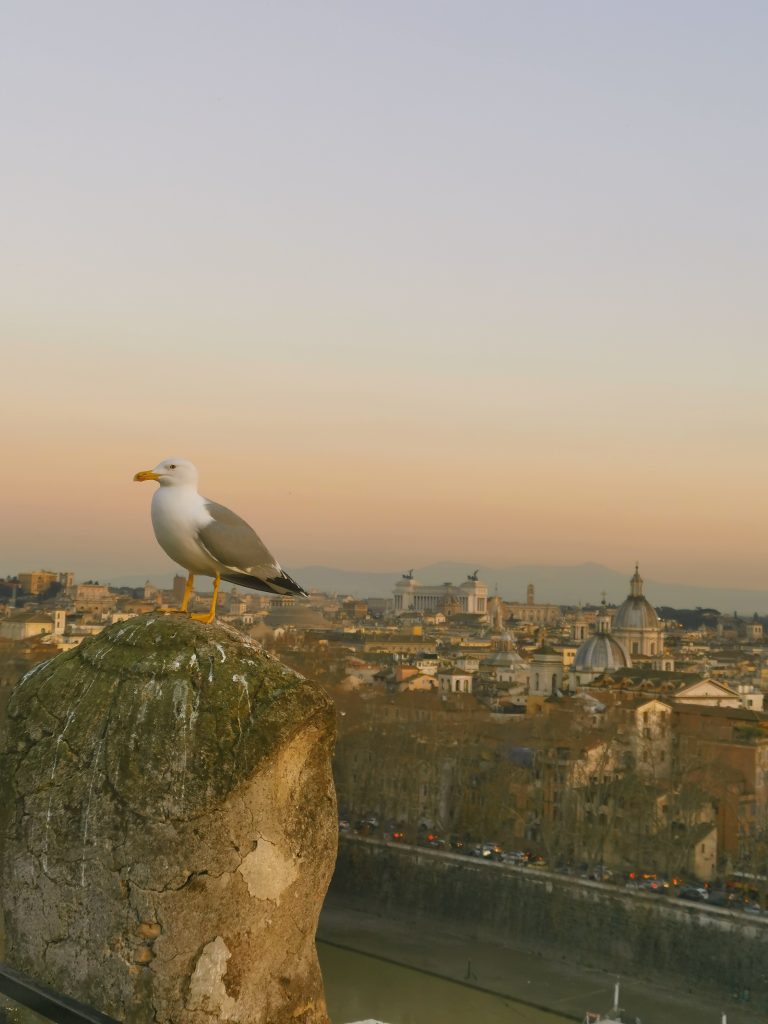
‘I believe in such cartography, to be marked by nature, not just to label ourselves on a map like the names of rich men and women on buildings. We are communal histories, communal books’ – The English Patient, Michael Ondaatje
